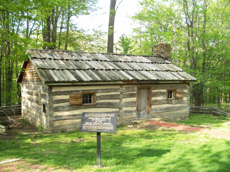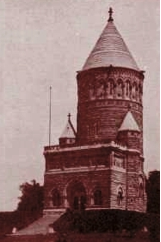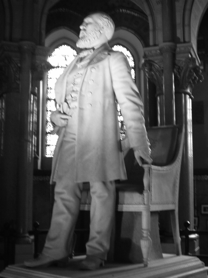Read on about Ohio’s own son who became the 20th president of the USA.
James A. Garfield (1831-1881)
James Abram Garfield, the last president to be born in a log cabin, was born in Orange Township, Cuyahoga County, Ohio, on Nov. 19, 1831. You may visit the replica of his birthplace by driving to Solon on Route 422 and north on Route 91 or by traveling west from Chagin Falls about 3 miles on Route 87 and then south on Route 91. Watch for it on the west side of the road.

Garfield the Entertainer
James Garfield became proficient in Greek and Latin while attending college. Before college he worked on the docks of Lake Erie where he was able to pick up the German language. Later, during his political life in Ohio, he was able to speak to his German constituents in their native tongue. As a parlor trick he would entertain his grandchildren or others by writing Greek with his right hand, writing Latin with his left hand, and speaking phrases in German at the same time.
Garfield’s Assassination
In 1881 an assassin shot Garfield twice in the back as he was walking through the Washington railroad depot to depart for a reunion at his alma mater, Williams College in Massachusetts. The assassin was Charles Guiteau, a lawyer. He had made an application for U.S. ambassador to France and when his application was rejected he vowed to murder the president for denying him a foreign post. At Guiteau’s trial he shouted, “Your honor, I admit to the shooting of the president, but not the killing.” This courtroom utterance was both rational and accurate. One bullet had grazed the president’s arm but the other had lodged internally. The doctors argued over the bullet’s location and what to do about it. They probed the wound with unclean fingers and instruments. Their ineptness finally weakened Garfield’s heart. For eighty days Garfield lingered while the bullet rapidly poisoning his blood. Finally on September 19th the once robust president moaned, “This pain, this pain.” Minutes later he died. The Washington Post was the first newspaper to accuse the doctors of malpractice. Williard Bliss, the first doctor to have examined the president, later admitted publicly that he had erred.
Charles Guiteau acted as his own defense attorney. To support his claim that he had only wounded the president, he introduced the attending physicians’ statements that said Garfield was not fatally shot on the 25th of July and that the president would recover. He calmly summed up his claim: “If he was not fatally shot….we say that his death was caused by malpractice. My defense here is that it is the Deity’s act and not mine.”
This did not save Charles Julius Guiteau from being hanged one year later. Government officials refused to turn Guiteau’s body over to his family or to bury it. The corpse was stripped of its tissue and it became a cleanly bleached skeleton. The surgeon general took custody of the dismantled bones and is supposed to have secretly disposed of them.
Garfield’s Will
Only 49 when he died, Garfield left no will. He had collected only a portion of his $50,000 salary, having been in office 200 days. His estate was valued at $61,733.06 and it passed on to his family then living in Mentor, Ohio. Just weeks before taking office, he had providentially taken out a life insurance policy for $25,000 with his wife as beneficiary. Congress, a year later, awarded his widow an annual pension of $5,000 plus a lump sum of $50,000.
The Garfield Memorial

Almost immediately after the assassination of President Garfield in 1881, a movement began in Cleveland to erect a monument to his memory. In 1883 architects were invited to submit competitive designs. The architectural plans of George W. Keller of Hartford, Connecticut were accepted. Contributions for Garfield’s monument came from every state and territory of the nation, and from many foreign countries. Construction began on the monument in 1885 at the Lakeview Cemetery located on the east side of Cleveland. The entire amount expended by the Trustees in and about the Garfield Memorial amounted to $225,000, of which the city of Cleveland contributed $75,000. The dedication ceremonies took place on Memorial Day of 1890.
The Garfield Memorial is an imposing structure which includes a 180 foot high tower built of native sandstone. The tower is crowned with a conical-shaped stone roof measuring 50 feet in diameter. There is a long, wide flight of steps leading up to a broad terrace facing a spectacular view of Lake Erie and the City of Cleveland. As one enters the tower they find themselves inside the Memorial Hall facing a white marble statue of Garfield.

This statue represents Garfield just rising from his chair in the Congress of the United States, and about to address the House of Representatives. In the crypt directly below the Memorial Hall are the bronze caskets of President Garfield (draped with an American Flag) and his wife Lucretia. It is interesting to note that the Garfield Memorial is called the first true mausoleum in America, a structure combining the tomb and memorial function. When built it was considered the fourth such structure in the world, after those of Mausolus at Halicarnassus and Metellus and Hadrian in Rome.
Lucretia Garfield (1832-1918)
Lucretia Rudolph was born in Hiram, Ohio, the daughter of Zebulon and Arabel Rudolph, who were farmers. Her father, helped fund the Eclectic Institute which was later named Hiram College. Here James Garfield studied as a young man and here he met Lucretia. When Garfield left Hiram for Williams College in Massachusetts, their friendship continued through letters. After graduating from college he married Lucretia at her father’s home, on November 11, 1858. In 1876 they purchased a farm one half mile west of Mentor, Ohio, which they named “Lawnfield”. Lucretia lived another 36 years after the president’s death, dying at Pasadena, California on March 14, 1918.
